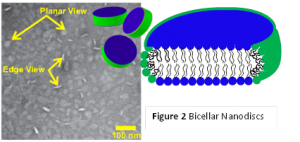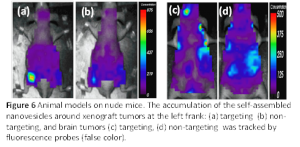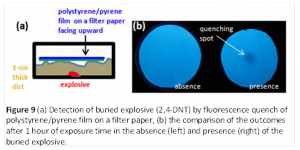- Table of Contents
- Structures of Uniform-sized Lipid Self-Assemblies
- Spontaneous Structural Diagrams of Bicellar Mixtures
- Bicellar Nanodiscs
- Nanovesicles
- Bilayered Ribbons
- Alignable Lamellae by Magnetic Field or Shear
- Interaction Between Nanoparticle And Cancer Cells
- Theranostic Delivery Nanocarriers
- Tumors-on-A-Chip
- Interaction between Polymers And Lipids
- Strung Lipid-Based Nanoparticles
- Instrument-Free, High-Sensitivity Biosensing
- Molecular Transfer between Nanoparticles
- Metal/Lipid Nanocomplex for Biodiagnosis
- Interaction between Fluorophores and Host Matrices
1. Lipid Self-Assemblies:
- Scientific Significance: Self-assembly is a complicated process which is ubiquitously observed in nature and involves interplay among several important parameters – hydrophobic-hydrophilic interaction, molecular packing parameter, Coulombic force, crystalline/amorphous immiscibility, kinetics. Our research aims to provide fundamental understanding of the formation mechanisms of these morphologies through structural characterizations. The knowledge obtained from this research enables scalable production of nanoparticles with low-cost processes.
- Applications: molecular templates (for hydrophilic and hydrophobic species), alignable substrates for membrane-associated proteins, delivery nanocarriers
Spontaneous Structural Diagrams of Bicellar Mixtures:
Bicellar mixtures are lipid mixtures composed of long- and short- chain lipids, which self-assemble into a variety of stru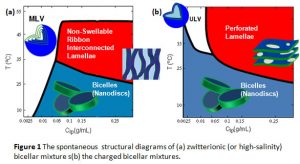 ctures including: nanodiscs (known as “bicelles”), unilamellar nano-vesicles, bilayered ribbons, alignable perforated lamellae, multilamellar vesicles, etc. Many features make “bicellar mixtures” attractive to the researchers in biochemical, biophysical and biomedical societies. First, the sizes in many of the nanoparticles are uniform at the nanoscale, e.g., well-defined radii of nanodiscs and nanovesicles, well-defined width of the bilayered ribbons. Moreover, the perforated lamellae of the bicellar mixtures under certain conditions are magnetically alignable, providing a way to align membrane-associated biomolecules in their native states (like a “goniometer”). Furthermore, the systems can serve ideal platforms for theragnostic carriers.
ctures including: nanodiscs (known as “bicelles”), unilamellar nano-vesicles, bilayered ribbons, alignable perforated lamellae, multilamellar vesicles, etc. Many features make “bicellar mixtures” attractive to the researchers in biochemical, biophysical and biomedical societies. First, the sizes in many of the nanoparticles are uniform at the nanoscale, e.g., well-defined radii of nanodiscs and nanovesicles, well-defined width of the bilayered ribbons. Moreover, the perforated lamellae of the bicellar mixtures under certain conditions are magnetically alignable, providing a way to align membrane-associated biomolecules in their native states (like a “goniometer”). Furthermore, the systems can serve ideal platforms for theragnostic carriers.
Some of the structures are kinetically trapped while others are possibly thermodynamically stable. Using small angle neutron scattering (SANS), we have successfully constructed spontaneous structural diagrams for a few mixtures as shown in Fig 1. A detailed explanation of some important morphologies is followed.
Fig. 2 illustrates a negatively-stained transmission electron microscopic (ns-TEM) image of uniform nanodiscs composed of long-chain (dimyristoyl phosphatidylcholine, DMPC) and short-chain (dihexanoyl phosphatidylcholine, DHPC) lipids (taken by Ming Li). The sketch indicates the proposed segregation of two lipids to form planar DMPC-rich bilayer (blue) and highly-curved DHPC-rich rim (green). The diameter and thickness of the nanodiscs are around 30 ~ 40 nm and 5 nm, respectively. The same discoidal structure has been observed in DMPC/Cholamidopropyl)dimethylammonio]-hydroxy-propanesulfonate (CHAPSO), dipalmitoyl phosphatidylcholine (DPPC)/DHPC systems under certain as well. The structure has been confirmed by small angle neutron scattering (SANS). This research is funded by NSF-CMMI nanomanufacturing (#1131587).
A nanodisc-to-nanovesicle transition takes place upon the elevation of temperature or dilution (see Fig 1). The vesicles normally inherit the uniform size from the nanodiscs and have radii in the range of 15 to 50 nm with a low polydispersity (standard deviation/average radius) < 30%. Fig 3 shows a cryogenic TEM (cryo-TEM) micrograph of a high-temperature charged DPPC/DHPC system, taken by Jaspreet Arora in Prof. Vijay John’s group at Tulane University. This structure has also been confirmed by SANS. It should be noted that the surface of the vesicles can be easily modified through hydrophobic anchoring of amphiphilic molecules or chemical conjugation.
Bilayered Ribbons:
Bilayer ribbons are normally found in non-charged lipid mixtures or high-salinity solutions around the melting transition temperature of the long-chain lipid. Fig 4 indicates a sketch of the bilayered ribbons, where long-chain lipids form the bilayer and short-chain lipids form the high-curvature edge. These ribbons can inter-connect with each other forming meshed-lamellae (as shown in Fig 1), which are alignable in a moderate magnetic field with their bilayer normal perpendicular to the magnetic field. Our recent study also shows that ribbons are more stable in DMPC/CHAPO than in DMPC/DHPC systems.
Alignable Lamellae in Solutions:
Most of the lipid membranes in solution form multi-lamellar vesicles, which are not alignable in solutions, while the bicellar mixtures are magnetically alignable in solutions with their bilayer normal perpendicular to the magnetic field, facilitating the structural analysis of membrane-associated proteins in physiologically relevant conditions. Such alignment is switchable through doping the lipid mixture with a small amount of paramagnetic ions (e.g., lanthanide group), resulting in the bilayer normal parallel with the magnetic field. The lamellae are presumably perforated (swiss-cheese like) bilayers with the short-chain lipids stabilizing the pore (defect) edges as shown in Fig 5. Recently, we have also found that shear flow is also capable of aligning free-standing membranes in solutions of lipid mixtures, providing an easier approach to align lipid membranes.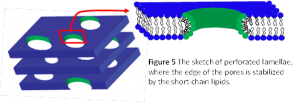
- Interaction Between NPs And Cancer Cells/Tumor Tissues:
Scientific Significance: The structures of the aforementioned lipid NPs are well-controlled, thus allowing us to study the interaction between NPs and cancer cells/tumor tissues. We have also designed tumor-on-a-chip to further the knowledge of NP diffusion in tumor tissues.
Applications: Optimization of the NP morphology for therapeutic/diagnostic delivery
Theranostic Delivery Nanocarriers:
Both bicellar nanodiscs and nanovesicles can entrap lipophilic molecules (e.g., Nile Red, cholesterol…), while the latter can also encapsulate hydrophilic molecules in the interior water core. Therefore, they can be used as therapeutic/diagnostic delivery carriers. Fig. 6 demonstrates promising results of the in vivo studies using the self-assembled, antibody-conjugated nanovesicles containing both fluorescence dyes (Cy5.5) and MRI (magnetic resonance imaging) contrast agent. In all cases, the nanovesicles were injected through the tail vein of the mice. Both xenograft tumor [Figs 6 (a) and (b)] and brain tumor [Fig 6 (c) and (d)] models indicate significant accumulation of nanovesicles when their surfaces were conjugated with appropriate antibodies. It paves a potential pathway for NPs to go across blood brain barrier (BBB).
Although targeting nanovesicles show encouraging results, more effective cellular uptakes were found using nanodiscs in an in vitro study compared to nanovesicles. Fig 7(a) and (b) (collected by Wafa Aresh) show the fluorescence optical microscopic images of three different cancer cell lines: CCRF-CEM (top), KB (middle) or ovarian (bottom) to illustrate the cellular uptakes of bicellar nanodiscs and nanovesicles, respectively. Both NPs (namely nanodiscs and nanovesicles) had the identical chemical composition (Nile Red/lipids) and concentration, and were incubated with cancer cells at 37 oC for two hours. After being washed and centrifuged, the cells were monitored using optical microscopy under the same configuration with red (left), blue (middle) or combined (right) channel. Hoechst was also used to dye the nuclei of the cells. Evidently the cellular internalization of bicellar nanodiscs is much more than that of nanovesicles.
Tumors-on-A-Chip:
A microfluidic device containing tumors in hydrogel is developed in collaboration with Prof. Pinar Zorlutuna (at the Univ. Notre Dame) to mimic the physiological environment of tumors embedded in the extra-cellular matrixes (ECM) as shown in the video of Fig 8. The result also indicates that nanodiscs diffuse more effectively through the ECM than the nanovesicles do 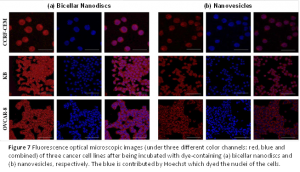 (collected by Wafa Aresh).
(collected by Wafa Aresh).
- Interaction between Polymers And Lipids:
- Scientific Significance: On biological membranes, hydrophobic/hydrophilic interaction is one of the most important parameters in controlling the membrane morphology. The interaction between simple amphiphilic macromolecules (e.g., block copolymers) and lipid NPs can provide important implication for some biological functions. The on-demand aggregating process can also be used as a platform for signal amplification.
- Applications:Biosensing, on-demand drug delivery.
Strung Lipid NPs:
We are able to “string” nanodiscs and nanovesicles together into clusters through an amphiphilic triblock copolymer as shown in Fig 9 (a negatively-stained TEM micrograph by Ying Liu). The formation of such shish-kebab structure is a result of hydrophobic-hydrophilic interaction. This research focuses on two aspects: (1) identification of the controlling parameters for final morphology of the “strung” NPs and (2) understanding of the clustering kinetics of the spontaneous “stringing” process.
Instrument-Free, High-Sensitivity Biosensing:
The principle of on-demand clustering process can be applied to detect pathogens, virus, biomarkers and toxins with high sensitivity. The strategy is to cluster the NPs containing dyes around the targets (e.g., pathogens) until visible-sized aggregations form. Samples of four different E-coli H157:O7 pathogen concentrations (i.e., 108, 106, 102 and 0 CFU/mL) were examined by anchoring E-coli H157:O7 pathogens on the glass slides, followed by clustering the targeting and Nile-Red containing NPs around the anchored pathogens through polymer/lipid interaction. As a result, the strung-NP clusters would cling to the substrate in presence of pathogens. Fig 10 (taken by Yan Xia) shows that the glass slides of all except for pathogen-free samples are covered by red NPs in full length, while the NP clusters precipitate at the bottom of vial for pathogen-free sample indicative of a promising platform for instrument-free, high-sensitivity pathogen detection.
- Molecular Transfer between Nanoparticles:
- Scientific Significance: Molecular transfer between nanoparticles controls many important biological functions. One example is to transfer excessive cholesterol from blood stream to disk-like high density lipoprotein (HDL). One of our research focuses is to investigate the transfer mechanism of molecules (e.g., lipids, hydrophobic molecules) from one to another aggregate at the molecular level in aqueous solutions. The transfer rate strongly depends on association-dissociation, diffusion and hydrophobicity of the molecules.
- Applications: treatment for cardiac diseases related to high cholesterol content.
- Result: Several approaches (including neutron scattering, fluorescence and differential scanning calorimetry) are applicable to identify the different controlling factors. More results will be updated soon.
- Interaction between Fluorophores and Host Matrices
- Scientific Significance: Fluorescence has been widely applied to sensing technology over decades. The environment of fluorophores can dictate their quenching efficiency, consequently
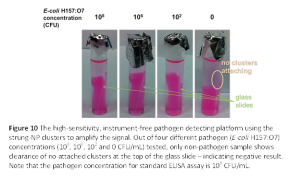 affecting their performance. Our research of correlating the fluorescence of pyrene excimer and its host matrix (molecular structure and physical properties) can lead to an important breakthrough for enhancing sensitivity of fluorophores.
affecting their performance. Our research of correlating the fluorescence of pyrene excimer and its host matrix (molecular structure and physical properties) can lead to an important breakthrough for enhancing sensitivity of fluorophores. - Applications:sensing materials.
- Result: Our research shows that the fluorescence of pyrene excimer strongly depends on flexibility and compositions of its host matrix (e.g., polymers, salts). Unique properties are observed when the host matrix contains tetrabutylammonium hexafluorophosphate, which incorporates with the solvent effect during the evaporation process can produce either highly fluorescence (prepared at high T) or complete quenching (prepared at low-T) materials. The pyrene/polymer films can be used for detecting buried nitro-explosives with high sensitivity as shown in 9(experiment done by Hyun-Sook Jang).
